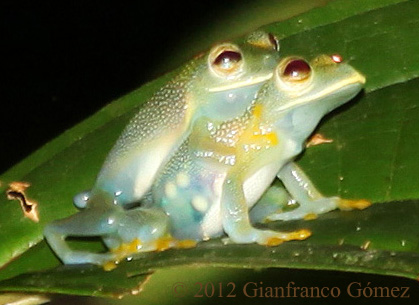Honest Signals
Biology 342 Fall 2015
Mikela Sheskier and Shirin Porkar-Aghdam
SURVIVAL VALUE
F U N C T I O N
What are some functional explanation regarding the current utility of the behavior?
How does the behavior increase the organism's lifetime reproductive success?
Aposematism in Granular Poison Frogs:
[Granular Glass Frogs in Axillary Amplexus] retrieved November 29, 2015 from: http://www.thenighttour.com/blog/There is a clear adaptive benefit to aposematism as such specialized coloration allows granular frogs to evade predation (Wang, 2011). However in conjunction with benefits leading to extended lifespan, aposematism may play an important role in mate preference and subsequently impact an individualís lifetime reproductive fitness and success. Research has shown that in conjunction with auditory information (i.e. mating calls) females selection of males was also heavily influenced by visual information, such as characteristics in body coloration (Dreher & Prohl, 2014). Research showed that females from two geographical locations displayed preference for more brightly colored males irrespective of locality when compared to less conspicuous male counterparts (Dreher & Prohl, 2014). Such results indicate the predation and natural selection are not the key impetuses for aposematic development and that sexual selection plays a driving force in aposematic differentiation (Maan & Cummings, 2012). |
Stotting:
[Showing relative survival rates in gazelles that either stot or don't stot] retrieved November 29, 2015 from:images/http-%3A%3Aethologie.unige.ch%3Aetho2.03%3Apar.date%3A2003_11_28.htmStotting has a number of functions that help the organism both survive and reproduce. The stotting may be an alarm signal to the herd that a predator is approaching or near. It may be a signal to the predator that it has been detected and thus there is no worth in pursuing the hunt. It may signal to the predator that the organism is strong enough to escape and thus the hunt should be terminated. It may distract the predator from offspring. IT may signify to a potential mate that the organsim is capable in doing all the things listed above and thus makes a favorable mate choice. Studies by FitzGibbon et al. (1988) have shown that despite its risks, stotting increases chances of survival when faced with a predator in Thomson's gazelles. |

